
One of my favorite aspects of Horizon: Zero Dawn (review) and Horizon: Forbidden West (review) was the sense of discovery. In Zero Dawn it was about uncovering Aloy’s mysterious past and her connection with the world at large. In Forbidden West it was taking all she’d learned and striking out into the unknown territories of the West to track down Sylens. Aloy’s story is hardly the only development of the 31st century, and Horizon: Call of the Mountain is one such story.
In Horizon: Call of the Mountain we join Ryas in the most unfortunate starting position of any protagonist – bound, a bag over his head, and headed to his inevitable execution. A member of the Shadow Carja clan, Ryas is brought to Sun-King Avad and given one chance to earn himself an unconditional pardon – climb Sunspear and uncover why the valley has recently been flooding with even more machines than before. A dangerous climb to be sure, but there’s a wrinkle – his brother Urid had already been given this task and has disappeared somewhere on that mountain. No matter the odds, this climb is now personal.
Before you set off on your grand adventure, you’ll need to calibrate your headset for the experience. Thankfully, the game supports a staggering amount of comfort options. Developer Firesprite is following the Sony trend of going well beyond the norm to make sure everyone can experience their adventure. First and foremost, you’ll spend a few moments calibrating your eye targeting – a major component of the foveated rendering used to bring this game to life with the highest fidelity possible. This links directly to “Gaze targeting”. If you’ve read our reviews on Tobii’s eye trackers on PC, you know that this works remarkably well, allowing you to select items from menus using only your eyes, with a button press to confirm. Like the PSVR1, holding the options button will re-center the headset, should you get spun around. Unlike the PSVR1, however, you can turn around. All the way around, in fact! The PSVR2 does not use light tracking to determine position, instead leaning on an impressive array of cameras and infrared to keep track of the headset and controllers.
Movement is handled one of two ways – “smooth motion” stick-based walking and turning, or “gesture based”. Gesture based has you progress by swinging your arms in a walking motion while holding a button on both controllers. Once you’ve decided how you’ll move forward and backward, it’s time to address turning. With or without smooth motion as a movement option, you can turn your head or even your entire body to face whatever direction you wish. With stick-based motion enabled you can flick left or right on the right thumbstick to snap 45 degrees in the selected direction. I’ve tried all of them and only smooth rotation presented immediate issues. The movement is far too slow, and it judders so badly as to cause immediate nausea. I ended up using a blend of snapping and physically turning to get the job done.

There are three prebuilt options for comfort to package these settings together. Comfort, Standard, and Expert. A quick visit to the options menu reveals that these are just quick-select choices – you can enable and disable every single option individually. Mix and match as you see fit and find what works for you.
Aloy is a master climber, and you’ll spend a lot of time climbing mountains and structures to uncover the mysteries therein. Ryas is also a master climber, and you’ll be putting those skills to the test. Ascending in VR is an incredibly tactile experience, and with the added haptic feedback in the Sense controllers and headset, along with the amazing graphical fidelity of the PS5, I experienced something completely new – a nervous feeling in my stomach.
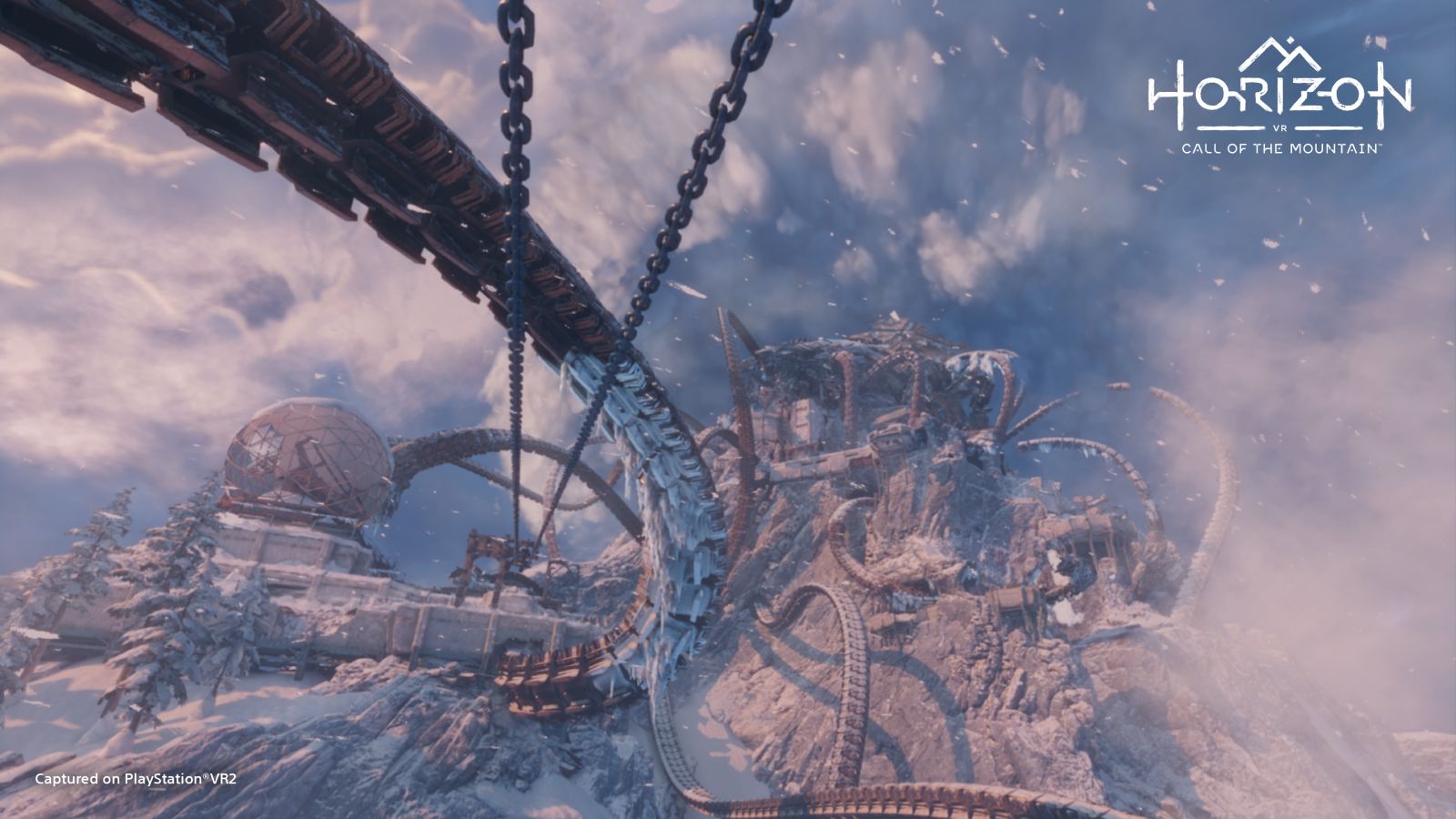
Climbing means reaching out and grabbing chalked edges of objects and then pulling yourselves upwards or sideways. The higher you climb, the more precarious perches and smaller handholds you’ll find. Nearing the top of the mountain I turned around and looked down. The draw distances in Horizon: Call of the Mountain are phenomenal, and I saw every inch of it unfold to the ground hundreds upon hundreds of feet below. My stomach tightened and the nervous feeling of dangling by my fingertips triggered a minor fight or flight. I quickly ambled my way across the edges. With my virtual feet on virtual terra firma, I peered over the edge. I’ve been playing VR games for almost a decade and have never experienced this – that was amazing, Firesprite, thank you!
One of the things that Horizon has always done well is scale. You’ll face smaller creatures like Watchers when you are first starting out, and eventually you are battling mechanical mammoths and massive sea monsters the size of a battleship. While it works well on the flat screen, there’s absolutely no way to describe the first time you see a Tallneck. Each creature is impossibly big, and with the help of VR, you can see them in more detail than ever. Honestly, a 3D viewer that let me just move around these creatures in virtual space would almost have been worth the price of admission.

The first thing you’ll notice when you get into the game is that it is absolutely gorgeous. The PlayStation 5 is inordinately powerful, and it looks like little to no compromise was made to bring this game to life. I think about the differences between this headset and a $1300 headset I have for my PC, and those differences are slight. As such, the graphical fidelity is top shelf. It doesn’t look like Firesprite made a game than the “dropped down the visuals” to make it VR. What they have done, however, is make me wonder what else is possible. Spider-Man: Miles Morales VR? I could easily see it. Ratchet & Clank: Rift Apart VR? Bring on virtual Rivet! Uncharted VR? Nathan Drake loves to climb, and I’d be here for it. With what the PSVR2 has shown to be possible, my head swims with possibilities.
Combat isn’t the primary focus of Horizon: Call of the Mountain, but that doesn’t mean you won’t be tangling with the world’s mechanical denizens. When you do, you’ll be introduced to an additional mechanic – dodging. During combat you’ll be somewhat stationary. Unleashing your bow (more on that in a moment), you’ll shoot the parts off the beasts, nipping at their weak points, just like in the non-VR games for greater effects. When they fight back, and they will, you’ll hold two buttons on the controller and swing your arms away from the target in a sweeping motion to escape. The fights essentially happen in a circle, so you’ll be sweeping around those targets rather quickly in an arc. You’ll also use a thumbstick or moving your head and body left and right to duck under incoming attacks. While I had to get used to the timing on the sweeping motion, the rest felt very natural and organic. Now let’s talk about the bow.
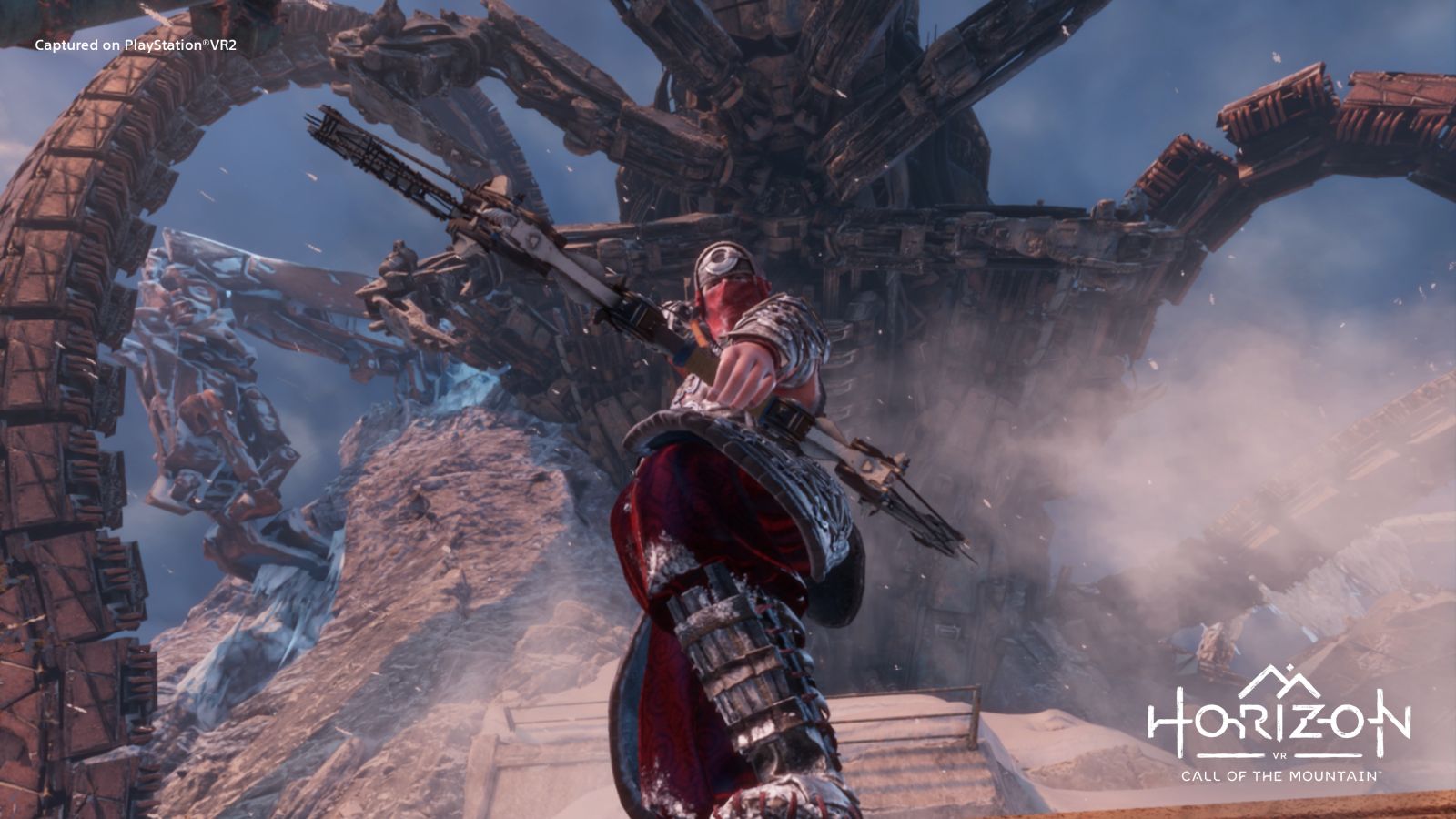
The bow is practically its own character in the Horizon games. It’s decorated with feathers, paint, beads, and the various trophies of the various hunts it’s been on. Bows are a huge staple of VR interactivity, but it’s rarely done this well. Popping the armor off of vulnerable points on a rapidly moving Glinthawk is an exercise in precision at speed. Taking down an entire pack of Stalkers on the other hand is pure panic and volume. Taking a breath, you’ll need to remember that each of these creatures has a weak point, and that preparation is key.
Once you’ve found the needed components, you can fashion specialized arrows. Turning your wrist upwards while holding the bow shows which arrows you have available. Reaching over with your other hand you can select the arrow and begin assembly. You’ll drag the fletching into position, attach the Blaze, and put an armored tip on them, completing an entire stack.
Back in the fight, inverting your wrist gives you access to the shock and blaze arrows. Loading those, and with a little patience, you can stun, set ablaze, and otherwise turn the tide against your foes, just like in the other Horizon games. That moment where it clicks and you start being the aggressor instead of being on your back heel is empowering and awesome.
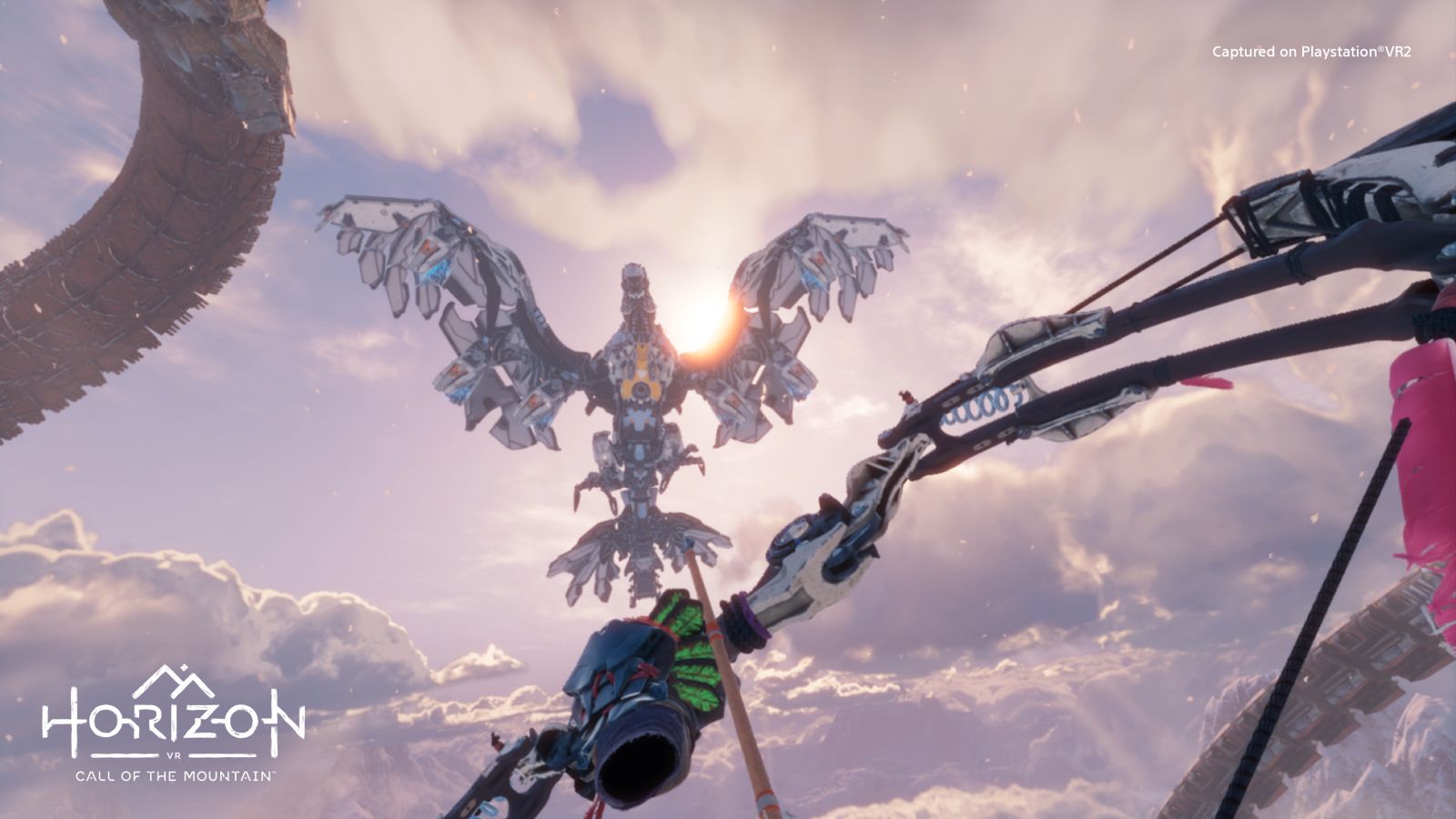
I did run into a bug, twice. When I get a new weapon, the game wants to give me an easy fight to learn how to use it. For whatever reason, during these fights my bow will only equip on my right hand, meaning I have to aim and draw opposite of what I’m used to. This tanks my aim and rhythm. Thankfully this goes away the moment that fight is over, and I can once again use the bow on my left hand with a right hand draw. The other instance, funny enough, happened on the shooting range.
You’ll unlock an adventure course after you get through a good portion of the game, allowing you to run a challenge course and shoot some targets for fun. Oddly enough, I had a heck of a time with the bow here, often having it switch hands on me, drop the bow to the ground, and lose targeting at the oddest of times. This never happened in the main game so undoubtedly it’s a bug, but no amount of lighting in the room or anything else would fix it. I do have to say – the safari is something you’ll want to do, even if it’s non-interactive. It’s the perfect way to introduce somebody to VR as well, so I’m glad they included it.
If you thought Aloy was a chatterbox, she’s got NOTHING on our protagonist. He will talk to himself at length and comment on just about everything in the game. “Blaze…that’ll light em up” is forever etched into my brain as he continues to say it no matter how many canisters I grab. It’s not quite aggravating, but it’s sitting right on the edge. You can start to see why this guy was shunned. “Hey, is that Ryas?” “Yeah, but leave him alone please. Otherwise he’s gonna start banging on about eating fruit or assembling arrows again”.
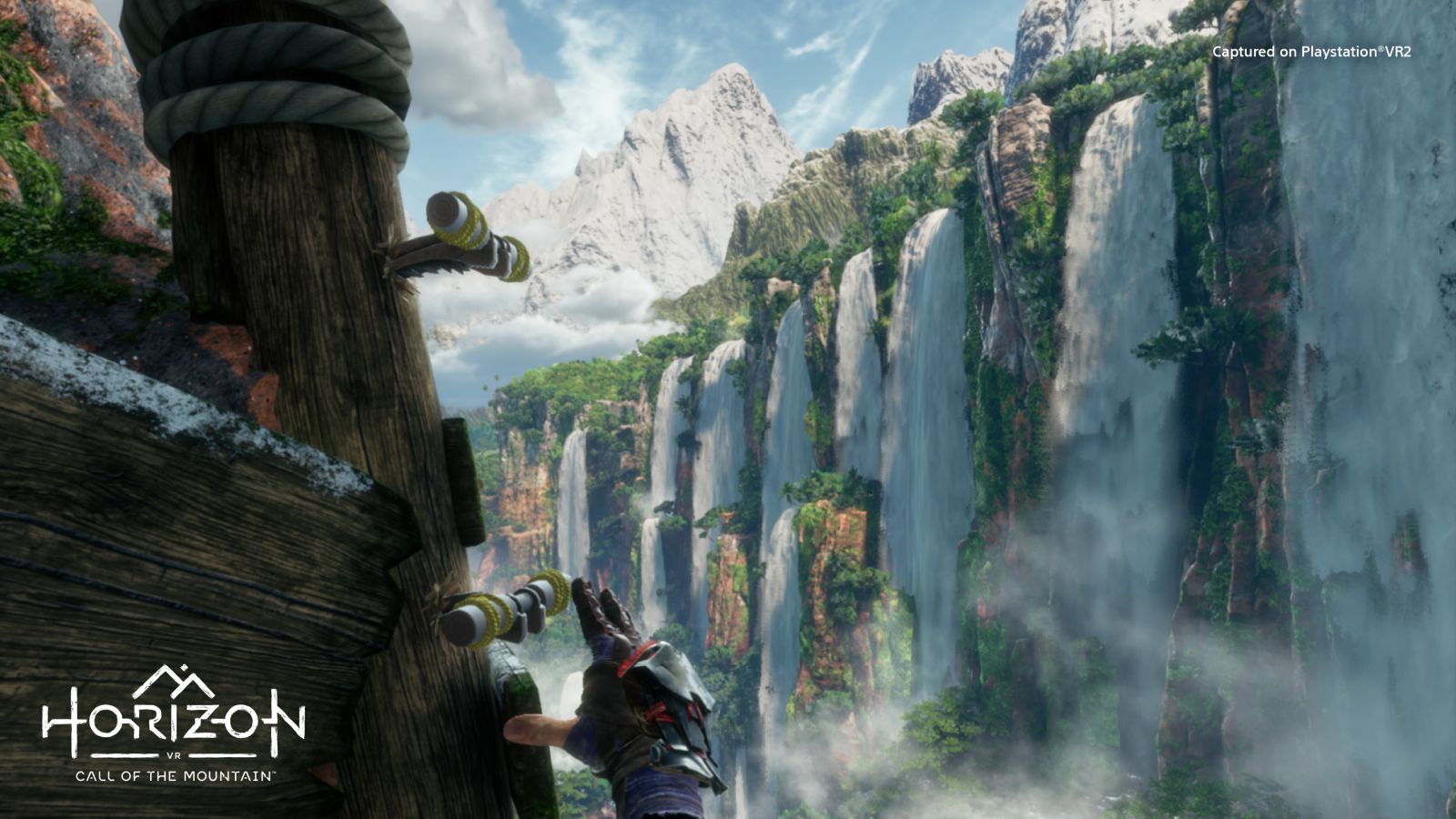
The bow is far from the only interactive element in the game. After the first mission you’ll sidle up to the crafting table to make your own climbing axes. Returning to the mountain you’ll climb using these axes, opening access to brand new areas. I won’t ruin any other methods of traversal, but these axes are far from the only time you’ll get new gear for the task at hand. One moment in particular had me making a crazy leap of faith over a massive chasm that once again gave me that tickle feeling, nearly missing an almost impossible grab that would have sent me to my death. I’ve played enough VR where new is a rarity, so when it happens, it’s awesome – this was awesome.
Between dangerous leaps, monsters that’ll cut you to ribbons, and some incredible vistas in all directions, there are a handful of distractions. Each area has a number of hidden targets to hit, and some require you to think about the task at hand in completely new and different ways. For example, my handhold was preventing me from pulling my bow and taking down one target – I instead whipped a climbing axe at it, breaking it. Another distraction is a cairn-stacking minigame. Using the absolutely phenomenal physics in the game, you’ll stack rocks into a cairn to mark your passage. They must reach a specified height to count, but beyond that is up to you. Steady hands and careful placement will win the day, but finding completely unexpected and crazy angles to stack the rocks in ways you didn’t think possible is even more rewarding. There are more to discover, but that’s for you to find on your climb.
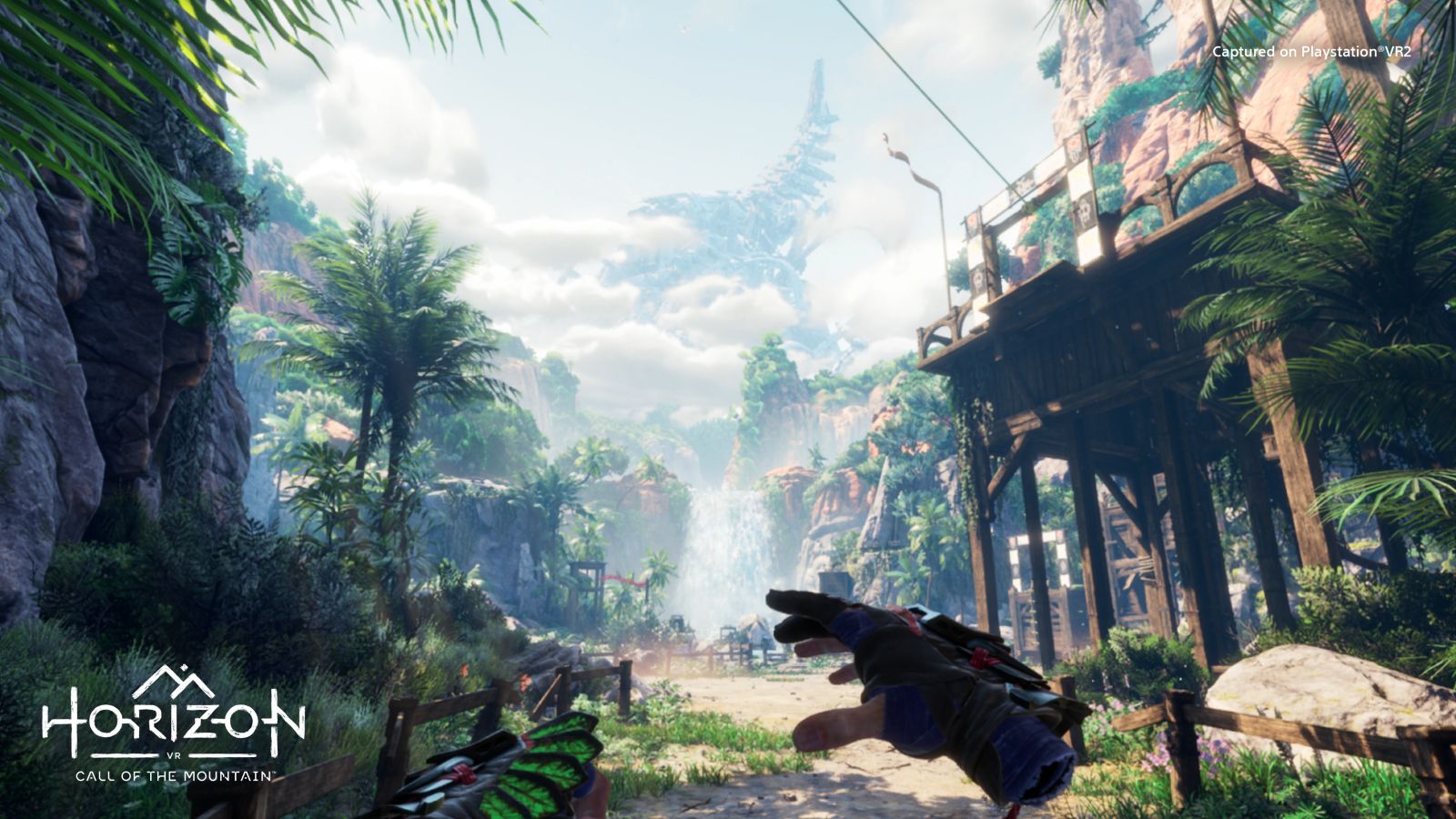
Ultimately you’ll spend about 7 hours on the story of Horizon: Call of the Mountain, and every bit of it feels carefully crafted. The main character’s motivations aside, the world that Guerilla has crafted can be experienced in a whole new way thanks to the hard work Firesprite put in, and it showcases what Sony’s new hardware can do perfectly. Now that we have some feature parity between the PlayStation 5’s headset and high end PCVR HMDs, folks have been asking for Valve to bring Half-Life Alyx to the platform. It’d be wonderful if that happened, but Sony already has a killer app to rival it. Horizon: Call of the Mountain is the system seller they needed, and they absolutely nailed it. If you are buying a PlayStation VR2, Horizon: Call of the Mountain is a must-have.
Horizon Call of the Mountain
Phenominal
Sony needed a system-seller for their PlayStation VR2, and Horizon: Call of the Mountain is it. Scale, interactivity, haptics, and satisfying combat that matches the main games makes for a must-have for anyone picking up Sony’s newest hardware.
Pros
- Absolutely gorgeous from top to bottom
- Interactivity is off the charts
- Haptics add a great deal to the experience
- Incredibly granular comfort options
- My first “Whoa!!” moment while climbing in a game
Cons
- Smooth turns are awful…but you don’t have to use it!
- Will you shut up already…
